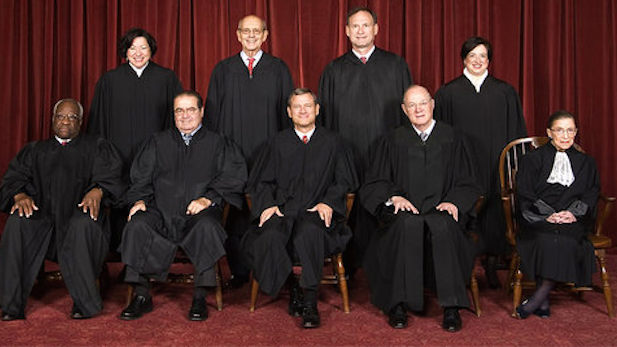 The nine justices of the U.S. Supreme Court.
The nine justices of the U.S. Supreme Court.Updated 3:20 p.m. on Tuesday, Dec. 8
Listen:
Listen:
The U.S. Supreme Court Tuesday heard a challenge to the drawing of Arizona's legislative districts.
A group of Republicans sued, saying the Arizona Independent Redistricting Commission drew legislative districts that violate the U.S. Constitution because their populations are unequal.
Some of Arizona’s districts are larger than others, and Republicans said in their lawsuit that dilutes the votes of people who live in the larger districts.
Joe Kanefield, lawyer for the commission, said there is a reason some districts are larger than others.
“The commission under-populated districts in an effort to comply with the Voting Rights Act," Kanefield said. "Because at the time that those maps were drawn, Arizona was a covered state under Section 5 of the Voting Rights Act.”
“We couldn’t draw any district that would dilute minority voting strength, specifically Native American and Hispanic voters," he said.
He also said the smaller districts lean Democratic because that is how most Hispanics in Arizona vote.
Eric Spencer, the state elections director, disagreed with Kanefield, saying the original map drawn by the commission was acceptable.
“In the draft map, the population numbers between districts were relatively equal and minority voting strength was still preserved,” Spencer said.
Spencer said 10 districts were in question, and the original map showed nine districts that were dominated by Hispanics and Native Americans. He said that map did not pack Republicans into other districts, which diluted their vote.
A federal appeals court has already ruled the current legislative district map is legal. Previous rulings from the Supreme Court said legislative districts can have as much as a 10 percent population deviation.
Kanefield said none of Arizona’s districts has that large a deviation.
Following the hearing, Secretary of State Michelle Reagan said the questions from the justices had a theme.
"How much partisan politics was at play and did it rise to the level of unconstitutional behavior?"
The Supreme Court is expected to rule on the case in the spring, and if so, that would not be in time to change the map before next November’s elections if the Redistricting Commission loses the case.
This is the second Arizona redistricting challenge to go to the Supreme Court this year. In June, the court ruled 5-4 upholding the Redistricting Commission's authority to draw boundaries for congressional districts.
Read the Transcript of the Supreme Court Hearing on AZ Legislative Districts
 View at Google Docs |
View at Google Docs |  Download File
Download File

By submitting your comments, you hereby give AZPM the right to post your comments and potentially use them in any other form of media operated by this institution.